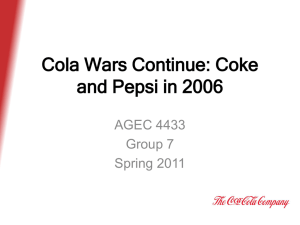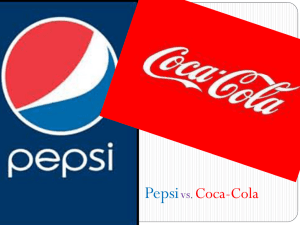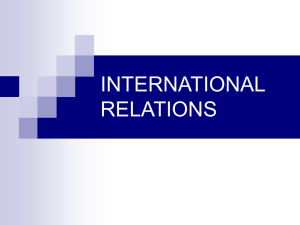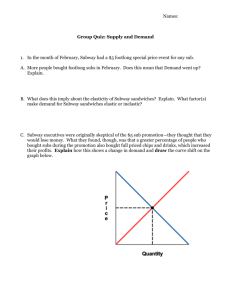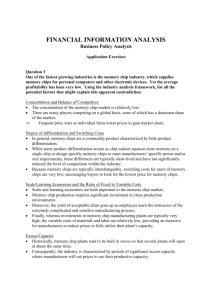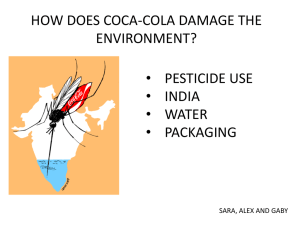Water Wars - Ivey Business Review
advertisement
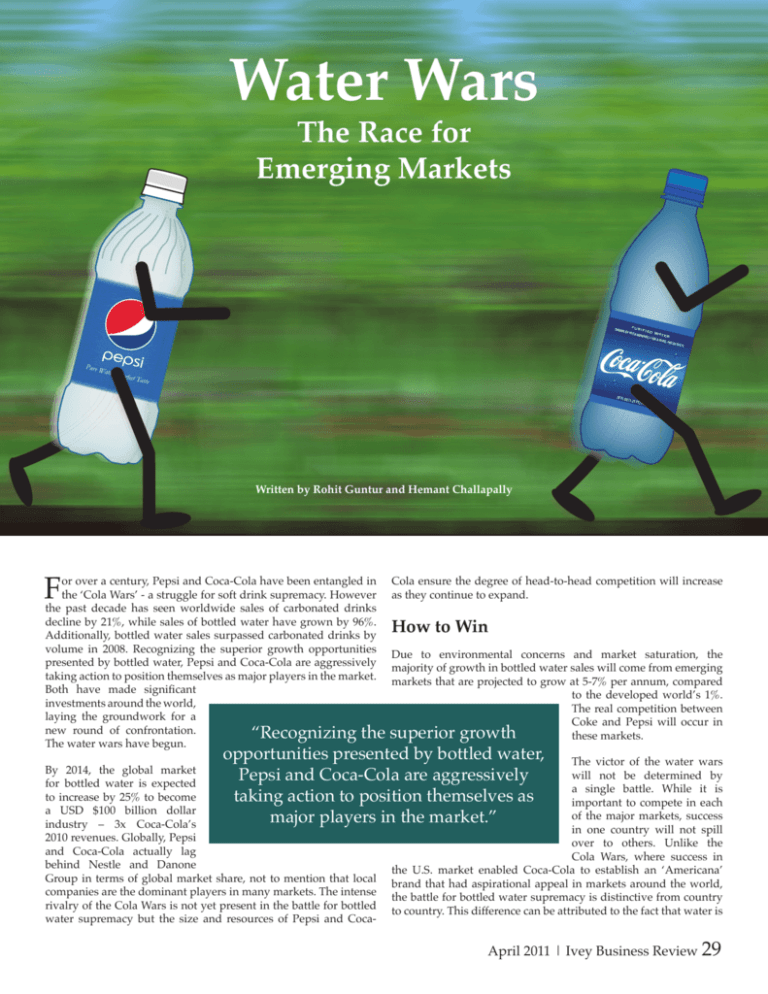
Water Wars The Race for Emerging Markets purif ENHANC ie ED WITH TH MINE d Wate r RALS LS FOR A PURE , FRREESSHH TA TASSTTEE Pure W atteer • P er fect Ta ste 20 FL OZ (1.25 PT ) 591 m L Written by Rohit Guntur and Hemant Challapally F or over a century, Pepsi and Coca-Cola have been entangled in the ‘Cola Wars’ - a struggle for soft drink supremacy. However the past decade has seen worldwide sales of carbonated drinks decline by 21%, while sales of bottled water have grown by 96%. Additionally, bottled water sales surpassed carbonated drinks by volume in 2008. Recognizing the superior growth opportunities presented by bottled water, Pepsi and Coca-Cola are aggressively taking action to position themselves as major players in the market. Both have made significant investments around the world, laying the groundwork for a new round of confrontation. “Recognizing the The water wars have begun. Cola ensure the degree of head-to-head competition will increase as they continue to expand. How to Win Due to environmental concerns and market saturation, the majority of growth in bottled water sales will come from emerging markets that are projected to grow at 5-7% per annum, compared to the developed world’s 1%. The real competition between Coke and Pepsi will occur in superior growth these markets. opportunities presented by bottled water, The victor of the water wars By 2014, the global market will not be determined by Pepsi and Coca-Cola are aggressively for bottled water is expected a single battle. While it is to increase by 25% to become taking action to position themselves as important to compete in each a USD $100 billion dollar of the major markets, success major players in the market.” industry – 3x Coca-Cola’s in one country will not spill 2010 revenues. Globally, Pepsi over to others. Unlike the and Coca-Cola actually lag Cola Wars, where success in behind Nestle and Danone the U.S. market enabled Coca-Cola to establish an ‘Americana’ Group in terms of global market share, not to mention that local brand that had aspirational appeal in markets around the world, companies are the dominant players in many markets. The intense the battle for bottled water supremacy is distinctive from country rivalry of the Cola Wars is not yet present in the battle for bottled to country. This difference can be attributed to the fact that water is water supremacy but the size and resources of Pepsi and Coca- April 2011 | Ivey Business Review 29 Water Wars much closer to a commodity than cola. It is not possible to establish an aspirational bottled water brand in developing markets. Race for India In order to win in any single market, companies will also require access to adequate water resources. Although not costly, water resources are limited in many countries, giving the holders key positions of power in the marketplace. Since transportation costs are high, it is not economical to move bottled water over long distances – increasing the importance of local supply. company that targets semiurban and rural areas. Parle Bisleri secured a first-mover advantage in these regions and has captured 39% of the market. Coca-Cola and Pepsi focused their efforts on urban consumers by leveraging existing distribution networks. While they achieved success in these markets, size is limited, with seven out of every ten Indians living in rural areas. The potential for bottled in water in India is staggering, as the Instead, the firms will compete largely on distribution, inch by country accounts for 17% of the world’s population and is expected inch, battle by battle. Due to the relatively commoditized nature of to pass China as the most populous country in the world by 2025, these products in developing markets, the primary differentiator according to the U.S. Census Bureau. to consumers is cost. The efficiency and breadth of distribution systems in each country are key determinants of success, since For years, the Indian consumer has demanded access to safe over 90% of the cost can be attributed to sources other than water drinking water but this demand has gone unanswered. This itself. As Pepsi and Coca-Cola expand their global empires through situation would typically this channel, this battle will result in inelastic demand, increase in intensity. In order something very attractive for to gain an advantage, both Pepsi and Coca-Cola. Both “... firms will compete largely on companies have considered firms, however, have struggled joint ventures with local to compete in this market. distribution, inch by inch, battle by companies as a means to Their dominant competitor battle.” quickly expand distribution. is Parle Bisleri, an Indian By evaluating distribution networks and local water supply, the winners in each of the three fastest growing markets of Mexico, India and China can be assessed. Race for Mexico Mexico has the highest consumption of bottled water in the world and continues to grow as a result of the widespread mistrust of tap water. Mexico provides a near term since the market is expected to grow quickly in the next five years. Pepsi currently maintains the upper hand with a 13% market share versus Coca-Cola’s 10%. However, Coca-Cola will surpass Pepsi over the final phase of growth due to two factors: superior water supply and entry into the 20-litre bottle market. Coca-Cola’s long-term advantage in Mexico will be driven by larger water supply. They have secured licenses to extract 29.5 million m3 of water, compared to Pepsi and Danone, which have only secured 7.9 million m3 and 4.8 million m3 respectively. As Mexican demand continues to grow, only Coca-Cola will have the ability to successfully supply it using low-cost, local water sources. The home delivery service for 20-litre bottles is an attractive segment because it eliminates the largest cost that suppliers face, bottle production, and therefore has higher margins. Coca-Cola’s $5 billion dollar, five-year investment strategy in Mexico challenges the two leaders in the 20-litre market, Bonafont (Danone) and Eloctropura (Pepsi). If they can secure a greater share of the 20-litre market, Coca-Cola will likely surpass Pepsi in market share in the coming years. Coca-Cola’s aggressive strategy has them well-positioned to defeat Pepsi in the battle for market share. Pepsi has laid its cards on the table and Coca-Cola has responded tactfully. Pepsi already has water brands for multiple segments and cannot make any significant moves to counter Coca-Cola. In fact, they should not make any moves. Coca-Cola will win the final battle in Mexico but there are bigger markets to be won. 30 April 2011 | Ivey Business Review It appears that Pepsi will defeat Coca-Cola in India due to its superior distribution networks. Pepsi recently announced a deal to partner with Tata, a huge regional player, to work together to redefine the concept of affordable water for Indians. Together, they plan to price a one-litre bottle below Rs. 10 – 33% lower than current prices. By working with Tata, Pepsi tapped into a strong Indian network but at a potentially high price. In return, they agreed to share some of their non-Indian distribution with Tata. India is a market that requires the utmost attention. By concentrating on rural communities, Pepsi can capture an additional 2 billion litres in volume over the next five years, an additional 10% in market share. This will give Pepsi a sizeable advantage and will establish itself, along with Parle, as a major leader in this market. To succeed in India, Coca-Cola must respond by replicating Pepsi’s strategy, targeting the Tier II and III cities outside the major hubs. These smaller and less developed cities are experiencing a rapid migration from the surrounding rural areas. Poor access to safe drinking water leads consumers to heavily rely on bottled water. However, what differentiates these markets from urban areas is income levels and frequency of purchase. These consumers are at lower income levels and thus buy water more frequently in smaller quantities. In order to capture this market, Coca-Cola must price its bottled water at a lower price point. The semi-urban market competes on volume and Coca-Cola has to sacrifice their margins to gain market share. By extending their bottling, distribution and marketing networks into these cities, Coca-Cola may be wellpositioned to close the gap between itself and Pepsi. Race for China The rapid economic growth and scale of the Chinese market provides a terrific opportunity for multinational beverage companies. Current levels of growth will likely continue, as consumers have embraced bottled water due to perceived health benefits. Also, significant local water demand exists, with 6.2 billion litres in unmet demand over the next five years. Water Wars Regional players occupy the top two spots in the Chinese market. Coca-Cola is in third place with a 9.2% market share, while Pepsi trails far behind. The drawback is that China is fraught with competitive and regulatory challenges that make growth elusive. The significant difference in market share between the two players is a huge advantage for Coca-Cola. For Pepsi to counter quickly, they can explore joint ventures in an effort to improve their distribution network. after price in the Chinese market. This strategy is obviously capital intensive but the short-term squeeze is what Pepsi must endure to be a significant player in the long term. This is not a Sprint It appears as though Coca-Cola will emerge victorious in China and Mexico, while Pepsi will take India. Winning each of these countries is a feat in itself because of competitive pressures At the same time, this strategy entails a high degree of risk. Take and regulatory hurdles. Within individual markets, Coca-Cola for example Danone, which and Pepsi must focus on created a joint venture (JV) in distribution and access to 2007 with a leading Chinese water in order to build and beverage manufacturer, retain competitiveness. To “By concentrating on rural communities, Wahaha. However, because respond to Coca-Cola’s of contract violations on Pepsi can capture an additional 2 billion current advantage, Pepsi Wahaha’s part, in which they should move into the semilitres in volume over the next five years, allegedly reproduced the urban markets and offer low JV’s products and sold it at an additional 10% in market share.” priced products to push higher lower prices, Danone left the volumes. Building sustainable Chinese bottled water market partnerships with regional completely in 2009. Pepsi, players will also help them unlike Danone, cannot afford to abandon the Chinese market. cultivate distribution channels throughout emerging markets. In order to succeed in China, Pepsi needs to improve its distribution network so it can reduce its price point. They currently operate on higher price points whereas the top players, all of whom are regional, dominate the market because they compete with the lowest prices. At the same time, Pepsi needs to invest in market heavily, given that brand loyalty is the second biggest consideration No singular victory, however, will guarantee success at a global level. In fact, in this commodity market there is no such thing as a sustainable, global, competitive advantage. Ultimately, in the wars over water, just like the Cola Wars that preceded it, there will be no winner. Emerging Water Bottle Markets 30 Mexico Danone 21% 17.2% 37% 25 16% 20 India 26% Parle Bisleri 39% 15 39% 7.4% 5.9% 10 7.0% 6.9% China 9% 4.6% 6.3% 14% 13% Hangzhou 9% 5 0.4% 0 India China Brazil Mexico US Indonesia Russia Turkey Bottled Water - Market Size in Billions of Litres 2011E 2015E CAGR (2011-2015) 77% Market Share by Country Coke Pepsi Other April 2011 | Ivey Business Review 31
